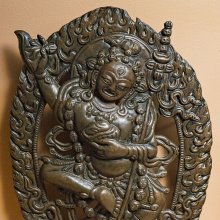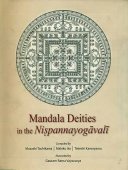Nairatmya, Nairātmya, Nairātmyā: 12 definitions
Introduction:
Nairatmya means something in Buddhism, Pali, Jainism, Prakrit, Hinduism, Sanskrit. If you want to know the exact meaning, history, etymology or English translation of this term then check out the descriptions on this page. Add your comment or reference to a book if you want to contribute to this summary article.
Images (photo gallery)
In Buddhism
Tibetan Buddhism (Vajrayana or tantric Buddhism)
Source: academia.edu: The Structure and Meanings of the Heruka MaṇḍalaNairātmyā (नैरात्म्या) or Nairātmyī is the name of a Ḍākinī who, together with the Vīra (hero) named Nairātmya forms one of the 36 pairs situated in the Hṛdayacakra, according to the 10th century Ḍākārṇava chapter 15. Accordingly, the hṛdayacakra refers to one of the four divisions of the sahaja-puṭa (‘innate layer’), situated within the padma (lotus) in the middle of the Herukamaṇḍala. The 36 pairs of Ḍākinīs [viz., Nairātmyā] and Vīras are reddish yellow in color; they each have one face and four arms; they hold a skull bowl, a skull staff, a small drum, and a knife.
Source: Brill: Śaivism and the Tantric Traditions (tantric Buddhism)Nairātmyā (नैरात्म्या) is the name of Hevajra’s consort, according to Ratnākaraśānti’s Bhramahara (Cf. Isaacson 2002, 162, lines 9-15).—Accordingly, the practitioner should generate himself as Hevajra in the First Union (ādiyoga). The practitioner, who has the form of the seed syllables, should enter the womb of Nairātmyā, Hevajra’s consort, through Hevajra’s mouth, become liquid (i.e. the state of śūnyatā), be emitted outside the womb, and have the form of Hevajra.
Source: MDPI Books: The Ocean of HeroesNairātmya (नैरात्म्य) refers to the “selflessness” (of phenomenal existences by nature), according to the 10th-century Ḍākārṇava-tantra: one of the last Tibetan Tantric scriptures belonging to the Buddhist Saṃvara tradition consisting of 51 chapters.—Accordingly, “[...] (The meaning of the letter he, i.e., the emptiness of cause and so on, etc.—) The letter he is [as follows]: From the heart, [he should visualize] all [deities], such as Heruka, [who] reside on their own circles. [Vajra-]holders and others are originating; [he should know] all [of them] originating through visualization. That [letter he represents the principle that] the cause is empty by nature; there is no conceptualization of cause and so on as selves. That [letter he refers to] the selflessness of phenomenal existences by nature (svabhāvadharma-nairātmya), [or the state of] being empty [Emptiness] brings the meditative union [...]”.

Tibetan Buddhism includes schools such as Nyingma, Kadampa, Kagyu and Gelug. Their primary canon of literature is divided in two broad categories: The Kangyur, which consists of Buddha’s words, and the Tengyur, which includes commentaries from various sources. Esotericism and tantra techniques (vajrayāna) are collected indepently.
Mahayana (major branch of Buddhism)
Source: academia.edu: A Study and Translation of the GaganagañjaparipṛcchāNairātmya (नैरात्म्य) refers to “egolessness”, according to the Gaganagañjaparipṛcchā: the eighth chapter of the Mahāsaṃnipāta (a collection of Mahāyāna Buddhist Sūtras).—Accordingly, “[...] The Bodhisattva Gaganagañja then sustained the jewel-canopy of ten thousand yojanas high over the Lord’s lion throne in the sky, joined the palms of his hands, saluted, and praised the Lord with these suitable verses: ‘[...] (20) He knows all living beings have egolessness (nairātmya), the realm of dharmas of the Omniscient has the same character, and the character of all dharmas is free from desire (virāga). Thus the Leader (nāyaka) having sameness (samatā) is honored. [...]”.

Mahayana (महायान, mahāyāna) is a major branch of Buddhism focusing on the path of a Bodhisattva (spiritual aspirants/ enlightened beings). Extant literature is vast and primarely composed in the Sanskrit language. There are many sūtras of which some of the earliest are the various Prajñāpāramitā sūtras.
General definition (in Buddhism)
Source: Wisdom Library: Dharma-samgrahaNairātmya (नैरात्म्य) refers to “two kinds of selflessnesses” as defined in the Dharma-saṃgraha (section 116).
- dharma-nairātmya (the selflessness of all things),
- pudgala-nairātmya (the selflessness of people).
The Dharma-samgraha (Dharmasangraha) is an extensive glossary of Buddhist technical terms in Sanskrit (e.g., nairātmya). The work is attributed to Nagarjuna who lived around the 2nd century A.D.
Source: archive.org: A History of Indian Philosophy (buddhism)Nairātmya (नैरात्म्य, “essencelessness”).—According to the Laṅkāvatārasūtra , p. 80-81, “... Just as a lump of clay is made into various shapes, so it is the non-essential nature of all phenomena and their freedom from all characteristics that is variously described as the garbha or the nairātmya (essencelessness)”.
In Jainism
Jain philosophy
Source: archive.org: Anekanta Jaya Pataka of Haribhadra SuriNairātmya (नैरात्म्य) refers to “soullessness”, as occurring in the Anekāntajayapatākā-prakaraṇa, a Śvetāmbara Jain philosophical work written by Haribhadra Sūri.—[Cf. Vol. I, P. 326, l. 5]
-
Languages of India and abroad
Sanskrit dictionary
Source: Cologne Digital Sanskrit Dictionaries: Edgerton Buddhist Hybrid Sanskrit DictionaryNairātmya (नैरात्म्य).—nt. (compare prec.; to Sanskrit nirātman plus ya), the not having a self; the doctrine that there is no self: Lalitavistara 9.10 etc.; 436.21 (see s.v. ātmya); Mahāvastu ii.145.10; 363.9; Mahāvyutpatti 783 °myādhigamāt; Kāśyapa Parivarta 97.2; Daśabhūmikasūtra.g. 20(356).14; Laṅkāvatāra-sūtra 1.4, etc.; two kinds, pudgala-n° and dharma-n°, Dharmasaṃgraha 116; Bodhisattvabhūmi 280.19—20 (see the next lines); dharma- n° Bodhisattvabhūmi 41.16. Cf. next.
Source: Cologne Digital Sanskrit Dictionaries: Monier-Williams Sanskrit-English DictionaryNairātmya (नैरात्म्य):—[=nair-ātmya] [from nair > naiḥ] n. ([from] nir-ātman), [Lalita-vistara] (cf. [Dharmasaṃgraha cxvi]).
[Sanskrit to German]
Sanskrit, also spelled संस्कृतम् (saṃskṛtam), is an ancient language of India commonly seen as the grandmother of the Indo-European language family (even English!). Closely allied with Prakrit and Pali, Sanskrit is more exhaustive in both grammar and terms and has the most extensive collection of literature in the world, greatly surpassing its sister-languages Greek and Latin.
Kannada-English dictionary
Source: Alar: Kannada-English corpusNairātmya (ನೈರಾತ್ಮ್ಯ):—[noun] = ನೈರಾತ್ಮ್ಯವಾದ [nairatmyavada].
Kannada is a Dravidian language (as opposed to the Indo-European language family) mainly spoken in the southwestern region of India.
See also (Relevant definitions)
Starts with: Nairatmyadvaya, Nairatmyavada, Nairatmyayogini.
Ends with: Atmanairatmya, Dharmanairatmya, Pudgalanairatmya.
Full-text: Nairatma, Two Selflessnesses, Hevajra, Two kinds of Selflessness, Nairatmyi, Atmya, Dharmanairatmya, Pudgalanairatmya, Nairatmyayogini, Hridayacakra, Pudgala, Viraga, Shunyata, Svabhavadharma, Adiyoga, Sankala.
Relevant text
Search found 17 books and stories containing Nairatmya, Nairātmya, Nairātmyā, Nair-atmya, Nair-ātmya; (plurals include: Nairatmyas, Nairātmyas, Nairātmyās, atmyas, ātmyas). You can also click to the full overview containing English textual excerpts. Below are direct links for the most relevant articles:
The Tattvasangraha [with commentary] (by Ganganatha Jha)
Verse 324 < [Chapter 7 - Doctrine of the Self (ātman, ‘soul’)]
Verse 3322 < [Chapter 26 - Examination of the ‘Person of Super-normal Vision’]
Verse 1043-1044 < [Chapter 16 - Examination of the Import of Words]
Nyaya-Vaisheshika categories (Study) (by Diptimani Goswami)
Asatkāryavāda (b): Pratītyasamutpāda-vāda < [Chapter 8 - The Theory of Causation]
Maha Prajnaparamita Sastra (by Gelongma Karma Migme Chödrön)
Introduction to fourth volume < [Introductions]
III. Fruits of the immeasurables (apramāṇa) < [Class 3: The four immeasurables]
Part 4 - Conditioned dharmas cannot have the three marks (lakṣaṇa) < [Chapter I - Explanation of Arguments]
A History of Indian Philosophy Volume 1 (by Surendranath Dasgupta)
Part 13 - Uncompromising Idealism or the School of Vijñānavāda Buddhism < [Chapter V - Buddhist Philosophy]
Mahayana Buddhism and Early Advaita Vedanta (Study) (by Asokan N.)
Chapter 2.2 - Structure of the Mula-Madhyamika-karika
Chapter 2.6 - Tathagata Pariksha (examination)
Vakyapadiya of Bhartrihari (by K. A. Subramania Iyer)
Verse 1.5 < [Book 1 - Brahma-kāṇḍa (or Āgama-samuccaya)]
Related products

